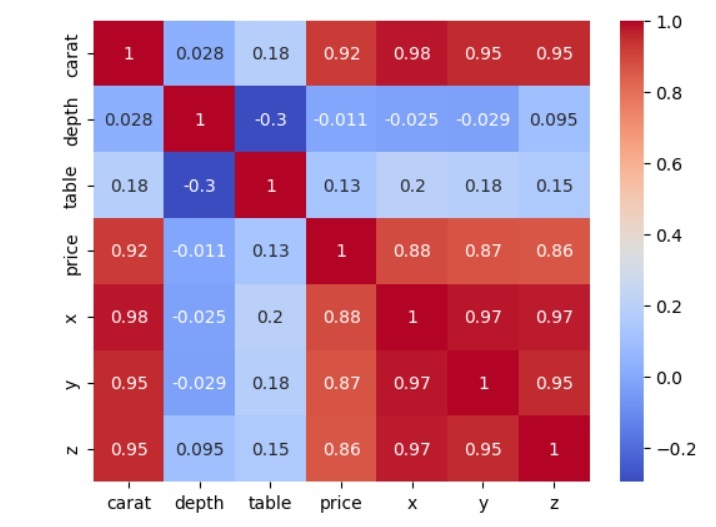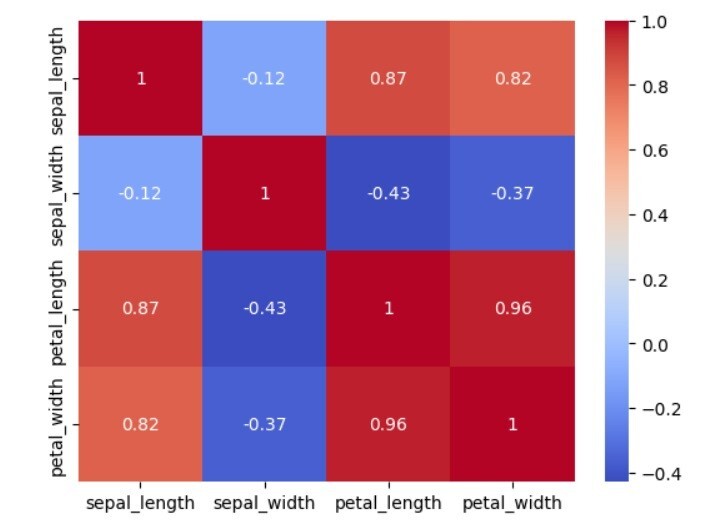How to create seaborn correlation heatmap in Python?
In the dataset, the strength and direction of the correlation between two pairs of variables is graphically displayed by a correlation heat map, which displays the correlation matrix. It is an effective technique for finding patterns and connections in large-scale data sets.
Python data visualization tool Seaborn provides simple tools to generate statistical visualization graphics. Users can quickly view the correlation matrix of a dataset through its ability to create correlation heatmaps.
We have to import the dataset, calculate the correlation matrix of the variables, and then use the Seaborn heatmap function to generate the heatmap to build the correlation heatmap. A heat map displays a matrix whose colors represent the degree of correlation between variables. Additionally, users can display the correlation coefficient on the heat map.
Seaborn Correlation heatmaps are an effective visualization technique for examining patterns and relationships in a data set and can be used to pinpoint key variables for further investigation.
Use Heatmap() function
The heatmap function generates a color-coded matrix illustrating the strength of the correlation between two pairs of variables in the dataset. The heatmap function requires us to provide the correlation matrix of the variables, which can be calculated using the corr method of the Pandas data frame. The heatmap function provides a number of optional options that enable the user to modify the visual effects of the heatmap, including color scheme, annotation, chart size and position.
grammar
import seaborn as sns sns.heatmap(data, cmap=None, annot=None)
The parameter data in the above function is the correlation matrix representing the input data set. The color map used to color heatmaps is called cmap.
The Chinese translation ofExample 1
is:Example 1
In this example, we create a seaborn correlation heatmap using Python. First, we import the seaborn and matplotlib libraries and load the iris dataset using Seaborn's load dataset function. This data set contains the SepalLength, SepalWidth, PetalLength, and PetalWidth variables. The iris data set includes measurements of sepal length, sepal width, petal length, and petal width of iris flowers. Here is an example of the message -
| Serial number | sepal_length | sepal_width | Petal length | Petal Width | Species | |
|---|---|---|---|---|---|---|
| 0 | 5.1 | The Chinese translation of3.5 | is:3.5 | 1.4 | 0.2 | Silk smooth |
| 1 | 4.9 | 3.0 | 1.4 | 0.2 | Silk smooth | |
| 2 | 4.7 | 3.2 | 1.3 | 0.2 | Silk smooth | |
| 3 | The translation of4.6 | is:4.6 | 3.1 | 1.5 | 0.2 | Silk smooth |
| 4 | 5.0 | Translated into Chinese:5.0 | 3.6 | 1.4 | 0.2 | Silk smooth |
Users can use Seaborn's load dataset method to load the iris dataset into a Pandas DataFrame. The correlation matrix of the variables is then calculated using the corr method of the Pandas dataframe and saved in a variable called corr_matrix. We use Seaborn's heatmap method to generate heat maps. We pass the correlation matrix corr_matrix to the function and set the cmap parameter to "coolwarm" to use different colors to represent positive and negative correlations. Finally, we use the show method of matplotlib's pyplot module to display the heat map.
# Required libraries
import seaborn as sns
import matplotlib.pyplot as plt
# Load the iris dataset into a Pandas dataframe
iris_data = sns.load_dataset('iris')
# Creating the correlation matrix of the iris dataset
iris_corr_matrix = iris_data.corr()
print(iris_corr_matrix)
# Create the heatmap using the `heatmap` function of Seaborn
sns.heatmap(iris_corr_matrix, cmap='coolwarm', annot=True)
# Display the heatmap using the `show` method of the `pyplot` module from matplotlib.
plt.show()
Output
sepal_length sepal_width petal_length petal_width sepal_length 1.000000 -0.117570 0.871754 0.817941 sepal_width -0.117570 1.000000 -0.428440 -0.366126 petal_length 0.871754 -0.428440 1.000000 0.962865 petal_width 0.817941 -0.366126 0.962865 1.000000
Example 2
In this example, we again use Python to create a seaborn correlation heatmap. First, we import the seaborn and matplotlib libraries and load the diamond dataset using Seaborn's load dataset function. The Diamond Dataset includes detailed information on the cost and characteristics of diamonds, including their carat weight, cut, color, and clarity. This is an example of information −
| Serial number | carat | The Chinese translation ofcut | is:cut | color | Clarity | The Chinese translation ofdepth | is:depth | surface | price | x | y | z | |
|---|---|---|---|---|---|---|---|---|---|---|---|---|---|
| 0 | 0.23 | The translation ofIdeal | is:Ideal | E | SI2 | 61.5 | 55.0 | Translated into Chinese:55.0 | 326 | The Chinese translation of3.95 | is:3.95 | 3.98 | 2.43 |
| 1 | 0.21 | Premium Edition | E | SI1 | 59.8 | 61.0 | 326 | 3.89 | 3.84 | 2.31 | |||
| 2 | 0.23 | good | E | VS1 | 56.9 | 65.0 | 327 | 4.05 | 4.07 | 2.31 | |||
| 3 | 0.29 | Premium Edition | The Chinese translation ofI | is:I | VS2 | The Chinese translation of62.4 | is:62.4 | 58.0 | 334 | 4.20 | 4.23 | 2.63 | |
| 4 | 0.31 | good | J | SI2 | 63.3 | 58.0 | 335 | 4.34 | 4.35 | The Chinese translation of2.75 | is:2.75 |
可以使用 Seaborn 的加载数据集函数将钻石数据集加载到 Pandas DataFrame 中。接下来,使用 Pandas 数据帧的 corr 方法,计算变量的相关矩阵并将其存储在名为 Diamond_corr_matrix 的变量中。为了利用不同的颜色来表示与函数的正相关和负相关,我们传递相关矩阵 corr 矩阵并将 cmap 选项设置为“coolwarm”。最后,我们使用 matplotlib 的 show 方法中的 pyplot 模块来显示热图。
# Required libraries
import seaborn as sns
import matplotlib.pyplot as plt
# Load the diamond dataset into a Pandas dataframe
diamonds_data = sns.load_dataset('diamonds')
# Compute the correlation matrix of the variables
diamonds_corr_matrix = diamonds_data.corr()
print(diamonds_corr_matrix)
# Create the heatmap using the `heatmap` function of Seaborn
sns.heatmap(diamonds_corr_matrix, cmap='coolwarm', annot=True)
# Display the heatmap using the `show` method of the `pyplot` module from matplotlib.
plt.show()
输出
carat depth table price x y z carat 1.000000 0.028224 0.181618 0.921591 0.975094 0.951722 0.953387 depth 0.028224 1.000000 -0.295779 -0.010647 -0.025289 -0.029341 0.094924 table 0.181618 -0.295779 1.000000 0.127134 0.195344 0.183760 0.150929 price 0.921591 -0.010647 0.127134 1.000000 0.884435 0.865421 0.861249 x 0.975094 -0.025289 0.195344 0.884435 1.000000 0.974701 0.970772 y 0.951722 -0.029341 0.183760 0.865421 0.974701 1.000000 0.952006 z 0.953387 0.094924 0.150929 0.861249 0.970772 0.952006 1.000000

热图是一种有益的图形表示形式,seaborn 使其变得简单易用。
The above is the detailed content of How to create seaborn correlation heatmap in Python?. For more information, please follow other related articles on the PHP Chinese website!

Hot AI Tools

Undresser.AI Undress
AI-powered app for creating realistic nude photos

AI Clothes Remover
Online AI tool for removing clothes from photos.

Undress AI Tool
Undress images for free

Clothoff.io
AI clothes remover

Video Face Swap
Swap faces in any video effortlessly with our completely free AI face swap tool!

Hot Article

Hot Tools

Notepad++7.3.1
Easy-to-use and free code editor

SublimeText3 Chinese version
Chinese version, very easy to use

Zend Studio 13.0.1
Powerful PHP integrated development environment

Dreamweaver CS6
Visual web development tools

SublimeText3 Mac version
God-level code editing software (SublimeText3)

Hot Topics
 1664
1664
 14
14
 1423
1423
 52
52
 1318
1318
 25
25
 1269
1269
 29
29
 1248
1248
 24
24
 PHP and Python: Different Paradigms Explained
Apr 18, 2025 am 12:26 AM
PHP and Python: Different Paradigms Explained
Apr 18, 2025 am 12:26 AM
PHP is mainly procedural programming, but also supports object-oriented programming (OOP); Python supports a variety of paradigms, including OOP, functional and procedural programming. PHP is suitable for web development, and Python is suitable for a variety of applications such as data analysis and machine learning.
 Choosing Between PHP and Python: A Guide
Apr 18, 2025 am 12:24 AM
Choosing Between PHP and Python: A Guide
Apr 18, 2025 am 12:24 AM
PHP is suitable for web development and rapid prototyping, and Python is suitable for data science and machine learning. 1.PHP is used for dynamic web development, with simple syntax and suitable for rapid development. 2. Python has concise syntax, is suitable for multiple fields, and has a strong library ecosystem.
 How to run sublime code python
Apr 16, 2025 am 08:48 AM
How to run sublime code python
Apr 16, 2025 am 08:48 AM
To run Python code in Sublime Text, you need to install the Python plug-in first, then create a .py file and write the code, and finally press Ctrl B to run the code, and the output will be displayed in the console.
 PHP and Python: A Deep Dive into Their History
Apr 18, 2025 am 12:25 AM
PHP and Python: A Deep Dive into Their History
Apr 18, 2025 am 12:25 AM
PHP originated in 1994 and was developed by RasmusLerdorf. It was originally used to track website visitors and gradually evolved into a server-side scripting language and was widely used in web development. Python was developed by Guidovan Rossum in the late 1980s and was first released in 1991. It emphasizes code readability and simplicity, and is suitable for scientific computing, data analysis and other fields.
 Python vs. JavaScript: The Learning Curve and Ease of Use
Apr 16, 2025 am 12:12 AM
Python vs. JavaScript: The Learning Curve and Ease of Use
Apr 16, 2025 am 12:12 AM
Python is more suitable for beginners, with a smooth learning curve and concise syntax; JavaScript is suitable for front-end development, with a steep learning curve and flexible syntax. 1. Python syntax is intuitive and suitable for data science and back-end development. 2. JavaScript is flexible and widely used in front-end and server-side programming.
 Golang vs. Python: Performance and Scalability
Apr 19, 2025 am 12:18 AM
Golang vs. Python: Performance and Scalability
Apr 19, 2025 am 12:18 AM
Golang is better than Python in terms of performance and scalability. 1) Golang's compilation-type characteristics and efficient concurrency model make it perform well in high concurrency scenarios. 2) Python, as an interpreted language, executes slowly, but can optimize performance through tools such as Cython.
 Where to write code in vscode
Apr 15, 2025 pm 09:54 PM
Where to write code in vscode
Apr 15, 2025 pm 09:54 PM
Writing code in Visual Studio Code (VSCode) is simple and easy to use. Just install VSCode, create a project, select a language, create a file, write code, save and run it. The advantages of VSCode include cross-platform, free and open source, powerful features, rich extensions, and lightweight and fast.
 How to run python with notepad
Apr 16, 2025 pm 07:33 PM
How to run python with notepad
Apr 16, 2025 pm 07:33 PM
Running Python code in Notepad requires the Python executable and NppExec plug-in to be installed. After installing Python and adding PATH to it, configure the command "python" and the parameter "{CURRENT_DIRECTORY}{FILE_NAME}" in the NppExec plug-in to run Python code in Notepad through the shortcut key "F6".





